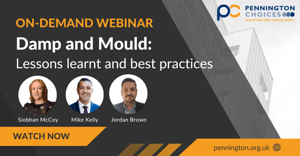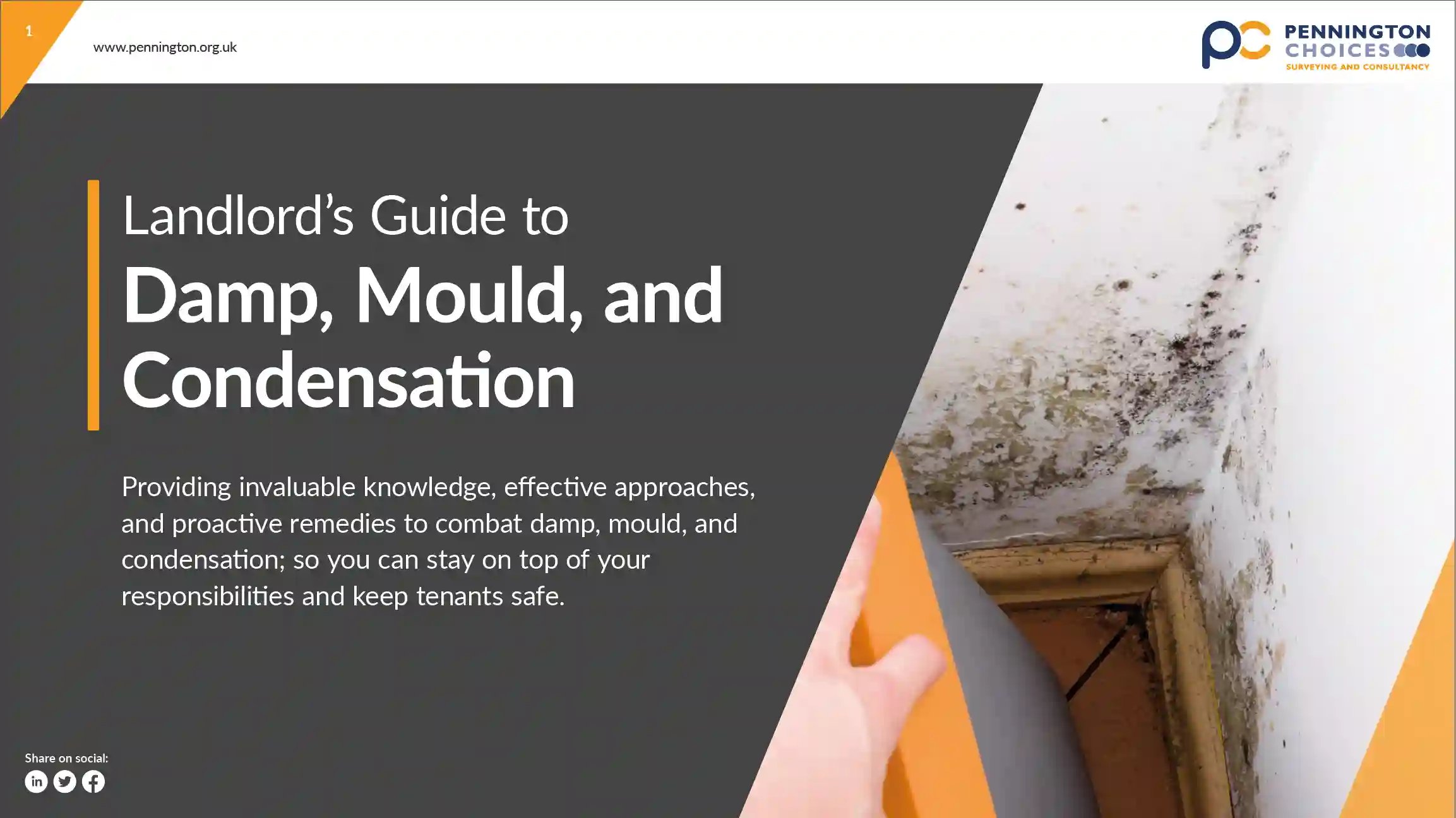Sign up to our newsletter
A fundamental principle of social housing is providing safe, stable, and affordable homes for tenants. Therefore, proactive measures must be taken to minimise risks and maintain a healthy environment.
Damp, mould, and condensation are persistent problems that can significantly affect the health and wellbeing of your tenants; problems which must be tackled effectively by landlords through a robust, responsive, and lasting approach. This includes shifting focus from not only treating the symptoms but treating the root causes of damp and mould, focusing on how to create healthier, quality living environments by preventing issues occurring in the first place.
In June 2023, the Regulator of Social Housing (the regulator) released their report on damp and mould and the lessons learnt, revealing that ‘fewer than 0.2% of social homes have the most serious damp and mould problems, 1-2% have serious damp and mould problems, and a further 3-4% have notable damp and mould’. The findings suggest that the majority of social landlords tackle damp and mould effectively, however there is a need for continued vigilance and proactive management of damp and mould by all.
 To find out how to proactively address damp and mould using the best practices our experts have seen within the sector, watch our on-demand webinar 'Damp and Mould: Lessons learnt and best practices'.
To find out how to proactively address damp and mould using the best practices our experts have seen within the sector, watch our on-demand webinar 'Damp and Mould: Lessons learnt and best practices'.
Your legal and regulatory requirements for property condition
First things first: your tenants’ safety is your upmost priority. But second to this is your legal responsibilities and obligations which must be met in order to ensure your organisation is compliant. Landlords are required to ensure their properties meet the legal minimum standard for housing as set out in the Housing Act 2004. Specifically, properties must be kept free from Category 1 hazards as defined in the Housing Health and Safety Rating System (HHSRS). These are hazards which arise from some sort of defect in the property that could create a risk to a tenant’s health and safety, including damp and mould and excess cold. You must also comply with the Landlord and Tenant Act 1985, as amended by Homes (Fitness for Human Habitation) Act 2018, which requires that your properties are fit for habitation, which in turn requires them to be free from dampness and other HHSRS hazards.
All social housing landlords must comply with the Decent Homes Standard, which sets out the minimum conditions for social housing, and also with the Regulator of Social Housing’s consumer standards, most specifically the Home Standard. The Home Standard requires landlords to ensure they are meeting all applicable statutory requirements around health and safety within tenants’ homes, providing cost-effective repairs and maintenance services when necessary that respond to the needs of the tenants. In July the Social Housing (Regulation) Bill received Royal Assent and will be coming into law over the coming months. The newly approved Social Housing (Regulation) Act 2023 aims to improve social housing quality by delivering ‘transformational change’ for social housing tenants. This will enable the regulator to implement a new, proactive consumer regulation regime that will enhance sector standards and ensure tenants’ needs are prioritised. The new set of consumer standards are stronger than before, giving tenants greater power to hold their landlord to account and enhanced powers for the regulator and the Housing Ombudsman.
Identifying the root cause of damp, mould, and condensation
To effectively address damp and mould in your properties, you must have a comprehensive understanding of their underlying causes. Being vigilant and proactive is key to being able to identify symptoms and investigate the root cause and then implement appropriate solutions. Common culprits of damp and mould include leaks, penetrating/rising dampness, inadequate ventilation and insulation, and inadequate heating. These factors may then cause routine household activities to exacerbate issues as additional moisture cannot be removed, further contributing to problems. However, to be absolutely sure of the cause and remedy, you must ensure you address the root cause(s) of the damp and mould. To do this you can arrange for a competent expert surveyor to undertake a damp and mould survey in your property. The survey will identify whether your building poses a potential health risk if damp and mould are present and will specify the remedial action required to address the risk, improve safety and address the root cause(s).
Taking action with a clear and effective approach to damp and mould
In order to take action against damp and mould, you need to know your assets, know your tenants, and know how to turn your data into knowledge and insight. Following your survey, which will have pinpointed the root cause of your damp and mould problem and identified the necessary remedial action required, you should ensure professional remediation is ordered without delay. Alongside addressing the properties you identify through surveys and by responding to service requests, you should use your data on what you have found about your properties and your tenants to identify other homes which are more likely to have problems, and groups of residents who may experience problems but have not reported them.
Building trust with your tenants
Throughout your whole approach to damp and mould, building trust with your tenants should be the cornerstone of your landlord-tenant relationship. This includes being open, honest, and actively engaging with your tenants to gain a thorough understanding of their concerns and problems relating to damp and mould. It’s also crucial that as a responsible landlord, you provide appropriate and supportive tailored advice to your tenants. After understanding the specific issues they are facing, offer guidance on how to prevent damp and mould becoming a recurring problem by educating your tenants on aspects such as proper ventilation practices, how to maintain indoor humidity levels, and identifying potential sources of moisture.
For your tenants who may be more vulnerable, such as the elderly, young children, or those with respiratory conditions, offering additional support and ensuring they receive this promptly and professionally is essential, whether that be through arranging repairs or providing additional resources. We must also eliminate any blame culture within the sector where ‘lifestyle issues’ are used to explain all issues. Damp and mould issues can be complex, arising from various different factors, and all tenants are entitled to live in a damp and mould free home. Landlords shouldn’t point fingers but focus on a collaborative approach that works with your tenants to find solutions.
Prevention is better than cure
Whilst addressing damp and mould once it has occurred is crucial, preventing issues from happening in the first place is even better. Preventative measures you can implement include: using accurate and up to date asset information, including a program of proactive inspections; adequate ventilation; and utilising asset data and surveyor / staff knowledge to identify stock most at risk of a damp problem. Ask yourself:
- Do any of your properties have any leaks or water damage?
- Do they have proper ventilation, especially in damp-prone areas such as bathrooms and kitchens?
- Are you responding promptly to your tenants when they report leaks, dampness, or mould?
It is important to note that specific preventative measures may be required; therefore, gaining a better insight into your properties will highlight this and allow proactive investment in stock and the implementation of measures to help manage moisture and heat within your homes.

Download
Landlord's Guide to Damp, Mould and Condensation
Discover the best methods of addressing damp, mould, and condensation to ensure compliance and safety within your buildings. Learn about:
• The importance of quickly identifying and addressing damp and mould within your properties.
• The causes and potential health implications of living with damp and mould.
• How to ensure you are compliant with regulations.







